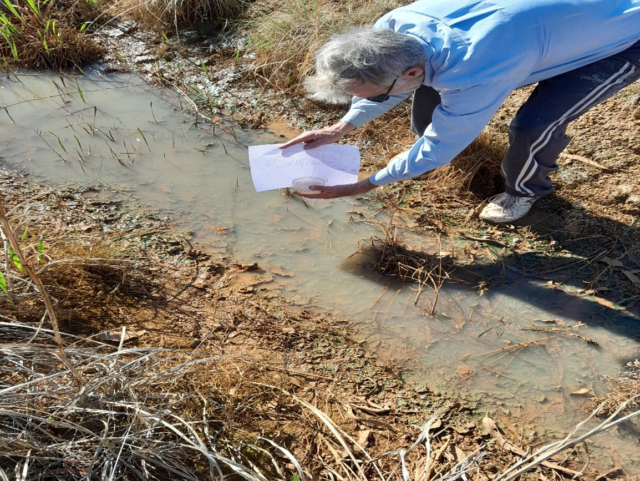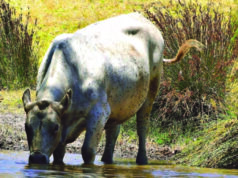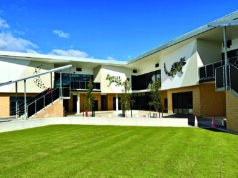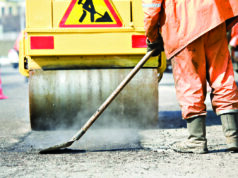Toxic levels of arsenic and chromium have been found in water samples taken from open drains lining the Cardup Business Park by a local resident.
Soldiers Rd resident John McEwan took the samples of water in September, acting on concerns that contaminated stormwater run-off was being discharged from the Permapole treated timber plant opposite.
The samples were tested by Envirolab – a NATA accredited laboratory in Myaree – and the results revealed arsenic levels at 170 micrograms per litre (µg/l), 17 times higher than the accepted limit in the Australian Drinking Water Guidelines.
The same national guidelines set a maximum limit for chromium of 50µg/l. Alarmingly, the Robertson Rd open drain water test results showed chromium levels at 850µg/l.
Mr McEwan, who paid for the water tests out of his own pocket, said he felt vindicated after the results confirmed his suspicions.
“And who knows how bad it really is. We’ve had a lot of rain – it could have been flushed all the way down to the Baldivis wetlands by now,” he said.
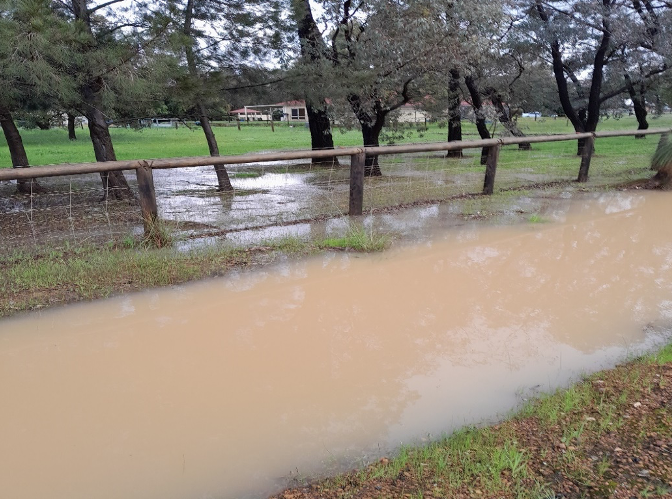
According to the Australian government, consumption of lower levels of arsenic can cause digestive tract pain, nausea, vomiting and other stomach disorders, decreased production of red and white blood cells, damage to blood vessels, abnormal heart rhythms, a ‘pins and needles’ feeling in the hands and feet, and liver and kidney damage.
Inorganic arsenic is also a known carcinogen and studies show that ingestion can increase the risk of skin, lung, bladder, liver, kidney or prostate cancer.
Arsenic also has a high short-term and long-term toxicity to aquatic life, birds and land animals.
Whereas chromium affects the skin and respiratory system, with unsafe exposure linked to skin lesions, allergic dermatitis, asthma, chronic bronchitis, pneumonia and emphysema.
Permapole is a prescribed premise and, according to its licence, pine logs are treated onsite with a copper chrome arsenate (CCA) solution in a pressure cylinder.
Once the treatment is complete, the treated timber is stored on a concrete bunded hardstand, until it has cured and CCA fixation has occurred, then it is stored in the yard.
When it rains, there is a risk that stormwater run-off will be contaminated with CCA, and there are drainage lines installed to direct the flow into a lined containment pond.
For at least the last 10 years, Permapole has been allowed by the Department of Water and Environment Regulation (DWER) to neutralise the water with lime and ‘drop down’ the metals with ferrous sulphate before releasing it offsite into the open drains on public land.
The company was obligated to test the water with a NATA-accredited lab before discharging it into public drains, which flow into natural waterways.
In a statement to council this month, local resident Karen McEwan explained that, in reality, eliminating CCA from water was a little more difficult.
“In the literature, even in stirred beakers in a laboratory, the levels specified by DWER, even in the best cases, could not be reached, despite using expensive oxidants such as hydrogen peroxide,” she said.
“It would be impossible to achieve these limits just by dumping chemicals into a dam. This is a well-known and documented concern in the preserved timber industry, since treatment of CCA wastewater is an expensive process.”

From September 29, the licencing regulations were altered and Permapole is no longer allowed to discharge treated wastewater and run-off from that central lined containment pond offsite.
“It baffles me that this wasn’t done years ago,” John McEwan said. “The most precious resource in this area is water.”
We asked DWER who was responsible for monitoring Permapole’s activities and their potential effects on surrounding amenity including the Bush Forever site, nearby residences, and their groundwater. And we also asked whether they had performed their own tests on surface water run-off from the Permapole site.
A spokesperson for DWER said: “The Department of Water and Environmental Regulation is investigating a community complaint regarding the Cardup Business Park area. As the matter is subject to an active investigation, the department are unable to provide any further comment at this time. Should any environmental enforcement actions be taken, they will be determined in accordance with the department’s compliance and enforcement policy.”
We asked the shire the same questions.
“There is no legislative requirement for activities such as groundwater monitoring of the Cardup Business Park by the shire. Rather, legislation is in place to ensure protection of the environment, including detailed mechanisms for anyone to report any emissions or discharges,” Deputy President Tricia Duggin said.
“State legislation mandates that any occupier causing or likely to cause environmental harm must notify the Department of Water and Environmental Regulation.
“The shire is actively investigating the recently reported issue in collaboration with the DWER.”
Cardup properties are generally not on mains water supply, with many relying on bore water.
And the shire has offered to test the water of nine properties in the area immediately in front of the Permapole site.
“The shire has contacted the DWER requesting groundwater monitoring be undertaken to investigate the matter further,” Ms Duggin added.
Mr McEwan said this case proves positive that “self-regulation is designed for disaster”.
“We have good solid environmental regulations and laws, however without the political will to administer and apply the laws and regulations, they are completely useless,” he said.
Permapole was approached for comment but no response was received before deadline.
CORRECTION: An earlier version of this article stated that DWER had changed Permapole’s licencing regulations and it was no longer allowed to discharge treated stormwater offsite. That condition change actually refers to wastewater and captured run-off in the lined containment pond within the central CCA-treatment area, and not to the entire plant.


